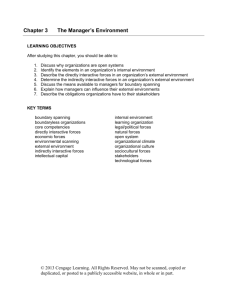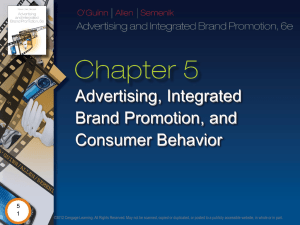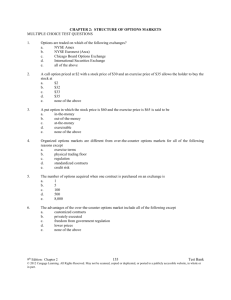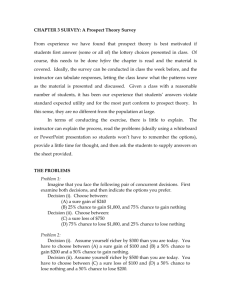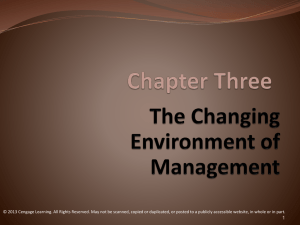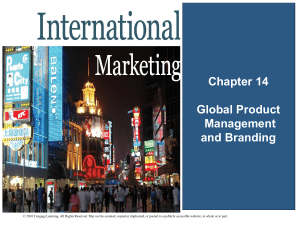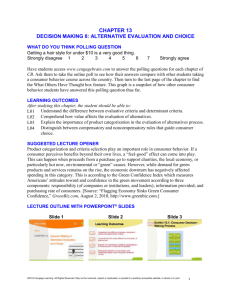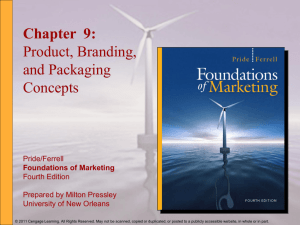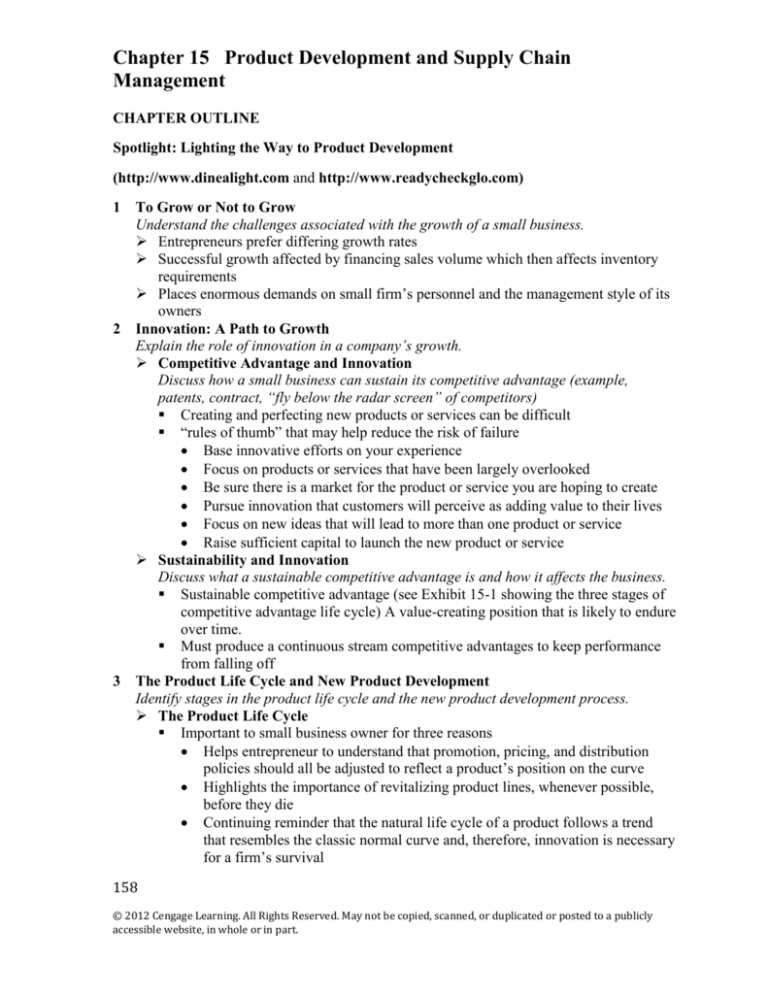
Chapter 15 Product Development and Supply Chain
Management
CHAPTER OUTLINE
Spotlight: Lighting the Way to Product Development
(http://www.dinealight.com and http://www.readycheckglo.com)
1 To Grow or Not to Grow
Understand the challenges associated with the growth of a small business.
Entrepreneurs prefer differing growth rates
Successful growth affected by financing sales volume which then affects inventory
requirements
Places enormous demands on small firm’s personnel and the management style of its
owners
2 Innovation: A Path to Growth
Explain the role of innovation in a company’s growth.
Competitive Advantage and Innovation
Discuss how a small business can sustain its competitive advantage (example,
patents, contract, “fly below the radar screen” of competitors)
Creating and perfecting new products or services can be difficult
“rules of thumb” that may help reduce the risk of failure
Base innovative efforts on your experience
Focus on products or services that have been largely overlooked
Be sure there is a market for the product or service you are hoping to create
Pursue innovation that customers will perceive as adding value to their lives
Focus on new ideas that will lead to more than one product or service
Raise sufficient capital to launch the new product or service
Sustainability and Innovation
Discuss what a sustainable competitive advantage is and how it affects the business.
Sustainable competitive advantage (see Exhibit 15-1 showing the three stages of
competitive advantage life cycle) A value-creating position that is likely to endure
over time.
Must produce a continuous stream competitive advantages to keep performance
from falling off
3 The Product Life Cycle and New Product Development
Identify stages in the product life cycle and the new product development process.
The Product Life Cycle
Important to small business owner for three reasons
Helps entrepreneur to understand that promotion, pricing, and distribution
policies should all be adjusted to reflect a product’s position on the curve
Highlights the importance of revitalizing product lines, whenever possible,
before they die
Continuing reminder that the natural life cycle of a product follows a trend
that resembles the classic normal curve and, therefore, innovation is necessary
for a firm’s survival
158
© 2012 Cengage Learning. All Rights Reserved. May not be copied, scanned, or duplicated or posted to a publicly
accessible website, in whole or in part.
Chapter 15 Product Development and Supply Chain
Management
The New Product Development Process
Idea Accumulation
First stage in new product development process
Many possible sources listed by authors (see page 451)
Business Analysis
Four key factors need to be considered in conducting a business analysis
The product’s relationship to the existing product line.
Cost of development and introduction
Available personnel and facilities
Competition and market acceptance
Development of the Physical Product
Product Testing
4 Building the Total Product
Describe the building of a firm’s total product.
Branding (Exhibit 15-3 Components of a Brand Identity)
Provide the name of a product such as Nike, then a product such as Popsicle. Ask
students to tell what they know about each based on the name. They discuss how each
relates to brand identity. Then ask the students what they think about when you say
Neiman Marcus. Follow with a discussion of the differences among the products and
the store branding.
Brand is a basic foundation for business. A verbal and/or symbolic means of
identifying a product
Used to shape a company’s future
Brand image – the overall perception of a brand
Brand name – a brand that can be spoken
Brandmark – a brand that cannot be spoken
Five rules apply in naming a product
Select a name that is easy to pronounce and remember
Choose a descriptive name
Use a name that is eligible for legal protection
Select a name with promotional possibilities
Select a name that can be used on several product lines of a similar nature
Very valuable to the business, Nike logo and Parking Spot logo good examples
Developing an effective logo – Tips
Be simple
Design for visibility
Leave it open to interpretation
Be relentlessly consistent
Recognize the importance of logo design
Get good advice
Don’t expect miracles
Trademark and service mark
Trademark – a legal term identifying a firm’s exclusive right to use a brand
159
© 2012 Cengage Learning. All Rights Reserved. May not be copied, scanned, or duplicated or posted to a publicly
accessible website, in whole or in part.
Chapter 15 Product Development and Supply Chain
Management
Service mark – a brand that a company has the exclusive right to use to identify a
service
Packaging
Relate a discussion on packaging back to the discussion on branding. Ask students to
indicate how they would expect a product to be packaged from Neiman Marcus as
opposed to a Popsicle.
Protects the basic product as well as increases the value of the total product
Creative packaging affected by financial issues
Labeling
To display the brand
Informative tool for consumers
Laws may affect
Warranties
Warranty – a promise that a product will perform at a certain level or meet certain
standards
Possible factors
Cost
Service capability
Competitive practices
Customer perceptions
Legal implications
5 Product Strategy
Discuss product strategy ad the alternatives available to small businesses.
Definitions
Product strategy – the way the product component of the marketing mix is used to
achieve a firm’s objectives
Product item – the lowest common denominator in the product mix-the individual
item
Product line – the sum of related individual product items
Product mix – the collection of a firm’s total product lines
Product mix consistency – the similarity of product lines in a product mix
Product – a total bundle of satisfaction - including a service, a good, or bothoffered to consumers in an exchange transaction
Product Marketing versus Service Marketing
Marketing services present unique challenges that are not faced in product
strategy development
Exhibit 15-5Services Marketing versus Goods Marketing
Product Strategy Options
Strategy alternatives of a small business condensed into six categories
One product/one market
One product/multiple markets
Modified product/one market
160
© 2012 Cengage Learning. All Rights Reserved. May not be copied, scanned, or duplicated or posted to a publicly
accessible website, in whole or in part.
Chapter 15 Product Development and Supply Chain
Management
Modified product/multiple markets
Multiple products/one market
Multiple products/multiple markets
Small firm can try to increase sales of an existing product by doing any or all of
the following
Convince nonusers in the targeted market to become customers
Persuade current customers to use more of the product
Alert current customers to new uses for the product
6 The Legal Environment
Recognize how the legal environment affects product decisions.
Consumer Protection
Federal regulations have important implication for product strategy
Example of two laws
Consumer Product Safety Act of 1972 and 2008
Nutrition Labeling and Education Act of 1990
Protection Of Marketing Assets
Trademarks
Protects a company’s distinctive use of a name, slogan, symbol, picture, logo,
or combination of these
Must be investigated to ensure they are not already in use
Registration of trademarks permitted under federal Lanham Trademark Act
Must be used properly
Make every effort to see that the trade name is not carelessly used as a
generic name
Inform the public that your trademark is exactly that by labeling it with the
symbol TM
Patents
Definitions
Patent – the registered, exclusive right of an inventor to make, use, or sell
and invention
Utility patent – registered protection for a new process or a product’s
function
Design patent – registered protection for the appearance of a product and
its inseparable parts
Plant patent – registered protection for any distinct, new variety of living
plant
Copyright – the exclusive right of a creator to reproduce, publish, perform,
display, or sell his or her own works
Lawsuits concerning patent infringements are costly and should be avoided, if
possible
Copyrights
Copyright Act of 1976
Notice consists of three elements
161
© 2012 Cengage Learning. All Rights Reserved. May not be copied, scanned, or duplicated or posted to a publicly
accessible website, in whole or in part.
Chapter 15 Product Development and Supply Chain
Management
The symbol ©
The year the work was published
The copyright owner’s name
Trade Dress
Elements of a firm’s distinctive image not protected by a trademark, patent, or
copyright
Valuable intangible asset
Now relate the protections to the two products and the store discussed previously
(Popsicle, Nike and Neiman Marcus). How do each of the protections relate?
7 Supply Chain Management
Explain the importance of supply chain management.
Definitions
Supply chain management – a system of management that integrates and
coordinates the ways in which a firm creates or develops a product or service,
delivers it to customers and is paid for it.
Distribution – physically moving products and establishing intermediary
relationships to support such movement.
Channel of distribution – the system of relationships established to guide the
movement of a product.
Physical distribution (logistics) – the activities of distribution involved in the
physical relocation of products
Discuss how the Internet and new software have affected current supply chain
management philosophy.
Intermediaries
Merchant middlemen – intermediaries that take ownership of the goods they
distribute
Agents / Brokers – intermediaries that do not take ownership of the goods they
distribute
8 Channels of Distribution
Specify the major considerations in structuring a distribution channel.
Exhibit 15-7 Channels of Distribution
Definitions
Direct channel – a distribution system without intermediaries
Indirect channel – a distribution system with one or more intermediaries
Dual distribution – a distribution system that involves more than one channel
Discuss the differences among these types of distribution.
The type of Distribution are affected by
Costs
Least expensive channel may be indirect
Determine whether the cost of using intermediaries is more of less expensive
than distributing the product directly to customers
Coverage – indirect channels may increase market coverage
Control
162
© 2012 Cengage Learning. All Rights Reserved. May not be copied, scanned, or duplicated or posted to a publicly
accessible website, in whole or in part.
Chapter 15 Product Development and Supply Chain
Management
Direct sometimes preferable because it provides more control
Determine how the product is best used and why it’s better than competitors’
offerings
The Scope of Physical Distribution
Transportation
Common carriers – transportation intermediaries available for hire to the
general public
Contract carriers – transportation intermediaries that contract with individual
shippers
Private carriers – lines of transport owned by shippers
Storage – lack of space common for small businesses
Materials handling – must have a suitable materials-handling methods and
equipment
Delivery terms
Who is responsible for:
Paying the freight costs
Selecting the carriers
Bearing the risk of damage in transit
Selecting the modes of transport
Third-party logistics firm (3PL) – a company that provides transportation and
distribution services to firms that prefer to focus their efforts on other business
aspects
9 Pulling the Pieces Together
Critical tasks of maintaining existing products and developing new ones, carefully
planning the product strategy and managing the supply chain must be managed
carefully.
ANSWERS TO END-OF-CHAPTER DISCUSSION QUESTIONS
1. Discuss some of the limitations on growth in a small firm.
As discussed in the chapter, some small firms want growth, while others do not.
For those with growth goals financing is a major limiting factor. Internally
generated cash flow may not support growth and external funds may be hard to
locate. Also, too much growth, too quickly, based on internal funding can be a
stress on current operations.
A firm’s personnel and management style of its owners is also a possible limitation
on growth. There simply may not be enough people and/or the right people to cope
with the growth.
163
© 2012 Cengage Learning. All Rights Reserved. May not be copied, scanned, or duplicated or posted to a publicly
accessible website, in whole or in part.
Chapter 15 Product Development and Supply Chain
Management
2. Describe the recommendations for reducing risk associated with innovation in a
small business.
The six “rules of thumb” listed and discussed in the chapter are:
a. Base innovative efforts on your experience
b. Focus on products or services that have been largely overlooked.
c. Be sure there is a market for the product or service you are hoping to
create.
d. Pursue innovation that customers will perceive as adding value to their
lives.
e. Focus on new ideas that will lead to more than one product or service.
f. Raise sufficient capital to launch the new product or service.
3. How does an understanding of the product life cycle concept help with product
strategy?
First, it helps the entrepreneur to understand that promotion, pricing, and
distribution policies should all be adjusted to reflect a product’s position on the
curve. Secondly, it highlights the importance of rejuvenating product lines,
whenever possible, before they die. Thirdly, it is a continuing reminder that the
natural life cycle of a product follows the classic sigmoid curve—a tiled S-shaped
curve describing the time line of life itself—and therefore, that innovation is
necessary for a firm’s survival.
4. Discuss briefly each stage of the product development process.
Idea Accumulation—The first stage that starts with the accumulation of ideas
from many sources.
Business Analysis—The next stage where costs and revenues are estimated and
analyzed. Any ideas judged not to be profitable are usually discarded here.
Development of the Physical Product—Here the idea is sketched to detail the
plan for branding, packaging, and other supporting efforts. Any actual prototype
may be built.
Product Testing—The last stage is testing of the physical product, maybe in a
market test environment
5. Select two product names, and then evaluate each with respect to the five rules
for naming a product.
Student answers will differ. Names chosen by students may not exemplify all of the
rules.
164
© 2012 Cengage Learning. All Rights Reserved. May not be copied, scanned, or duplicated or posted to a publicly
accessible website, in whole or in part.
Chapter 15 Product Development and Supply Chain
Management
6. What are the six basic product strategy options available to a small company?
Which ones are most likely to be used?
Product strategy describes the manner in which the product component of the
marketing mix is used to achieve the objectives of the firm. The major product
strategy alternatives can be described by the following six categories:
a. One product/one market
b. One product/multiple markets
c. Modified product/one market
d. Modified product/multiple markets
e. Multiple products/one market
f. Multiple products/multiple markets
A small company usually works through the alternatives in the order listed.
7. Identify and briefly describe the three ways to increase sales of an existing
product once a product strategy has been implemented.
A small firm can try to increase sales of an existing product by doing any of all of
the following:
Convincing nonusers in the targeted market to become customers
Persuading current customers to use more of the product
Alerting current customers to new uses for the product
8. Explain how registration of a small firm’s trademarks would be helpful in
protecting its brand.
Because small firms do not have the same level of market exposure as large firms,
it is important that they establish and maintain an identity with their current and
potential customers. One way of doing this is by establishing an identifying
trademark that will help to carry the message of the firm to the market. Once the
trademark is registered, the small firm gains valuable protection from larger firms
that may be interested in entering the same market and taking away any advantage
the small firm may have.
9. Why do small firms need to consider indirect channels of distribution for their
products? Why involve intermediaries in distribution at all?
Small firms use indirect channels for reasons similar to those of large firms.
Primarily, intermediaries exist to carry out unavoidable marketing functions that
they can perform better than the producer or the user of a product. It is an accepted
premise in marketing that functions of marketing cannot be eliminated, but they can
165
© 2012 Cengage Learning. All Rights Reserved. May not be copied, scanned, or duplicated or posted to a publicly
accessible website, in whole or in part.
Chapter 15 Product Development and Supply Chain
Management
be shared and/or shifted. Small firms cannot always perform these necessary
functions, and since someone must perform these, intermediaries are involved.
10.
Discuss the major considerations in structuring a channel of distribution.
Looking at the competition is an important first step in building a channel of
distribution, because the competition’s experiences can guide the newcomer. Other,
more specific elements to consider in structuring a channel are costs, coverage, and
control. These are the “three Cs” of channel choice.
Costs associated with an indirect channel of distribution must be evaluated against
the expenses that the small business would otherwise incur in performing the
function itself. For example, how do the costs of using a wholesaler compare with
the costs of selling directly to retailers? Distribution costs should be viewed as an
investment.
Coverage refers to contacts with potential customers. An indirect channel of
distribution can greatly increase market coverage—that is, the number of customers
or potential customers that can be reached.
A direct distribution channel provides more control than an indirect one. For
example, a manufacturer can exert more control over retail sales promotion efforts
by selling directly to retailers than by going through a wholesaler. All of these facts
must be evaluated jointly.
COMMENTS ON CHAPTER “YOU MAKE THE CALL” SITUATIONS
Situation 1
Where would be the best locations for the MooBella Ice Creamery Machine?
Good locations would include malls, movie theaters, Airports, bus stations,
school cafeterias, college campuses, and businesses (e.g. lunch rooms, snack
areas.)
1.
2.
What are the primary advantages and disadvantages of this innovation?
The primary advantage of the MooBella ice-cream machine is that labor costs are
low. No retail salespeople are needed and it reorders its own ingredients.
Limitations include where the vending machines can be located, vandalism, and
limited product offerings compared to an ice-cream store.
Situation 2
1. What are the advantages and disadvantages of the in-home method of selling
Tomboy Tools?
166
© 2012 Cengage Learning. All Rights Reserved. May not be copied, scanned, or duplicated or posted to a publicly
accessible website, in whole or in part.
Chapter 15 Product Development and Supply Chain
Management
The primary advantage of in-home sales is the relationship between the buyers and
seller. Often buyers are friends or co-workers of the seller and will feel obligated
to buy something. The relaxed friendly atmosphere is also conducive to sales.
2. What other channels of distribution might Tomboy Tools use?
The Internet would certainly be worth considering direct mail and personal selling
to retailers may also be effective. And don’t overlook the potential that companies
like Home Depot and Lowe’s hold for the Tomboy line of tools.
3. What do you think about the name Tomboy Tools?
It is a good one. It is easy to pronounce, distinctive, memorable, and descriptive of
the product offering. It resonates with its intended target market – women and can
used across may product lines.
Situation 3
2. What is it about Monster’s logo that makes it effective? Hint: What tips does this
textbook provide regarding logo design?
It is simple, open to interpretation, used consistently across various monster
products, is well designed, and eye-catching.
3. How can good packaging help a product?
Packaging sets the tone/image for your product and conveys important information
about a product. Good packaging is eye-catching and communicates with the
consumer at the point of sale
4. Why is labeling an important part of the packaging for energy drinks like
Monster?
First, the list of the ingredients helps sell the product. Energy drink buyers are
looking for certain ingredients. Consumers want to know what they are getting and
read closely to compare sugar and caffeine levels as well as the presence of other
ingredients
SUGGESTED SOLUTION TO CASE 14: GRAETER’S ICE CREAM
167
© 2012 Cengage Learning. All Rights Reserved. May not be copied, scanned, or duplicated or posted to a publicly
accessible website, in whole or in part.
Chapter 15 Product Development and Supply Chain
Management
1. What distinguishes Graeter’s Ice Cream from other ice cream makers and makes its
products desirable to consumers?
When ice cream makers entered the grocery store market, most competitors built business
on volume and lower prices, and quality suffered. Graeter’s continued with its timeconsuming Fresh Pot process of spinning the recipe along a chilled container. Its retail
outlets offer consumers a distinctive buying experience, and ice cream continues to be the
company’s staple, enabling the small business to gain a national reputation.
2. While its ice cream was a success from the start, what innovations has the company
made to sustain its competitive advantage?
Graeter’s offers its ice cream in grocery stores, they developed a line of candy and bakery
goods, utilized mail-order sales, has an aggressive marketing effort, formed a strong
alliance with the Kroger grocery chain, expanded its distribution network to include
restaurants and country clubs, and operates an online store that offers overnight shipping
in 48 states. Also, the company has diversified its portfolio by offering a line of ice cream
cakes and pies, travel packs, and sundaes, in addition to baked goods and candies. The
company is committed to further expansion and boosted its production capacity from one
factory to three, aiming for distribution to even more supermarkets and grocery stores
throughout the country.
3. Cite examples of Graeter’s Ice Cream’s supply chain management. Explain how the
company uses direct channel and indirect channel distribution.
Direct channel: Graeter’s own stores, mail-order, and online ordering
Indirect channel: Grocery stores, restaurants, country clubs
168
© 2012 Cengage Learning. All Rights Reserved. May not be copied, scanned, or duplicated or posted to a publicly
accessible website, in whole or in part.





